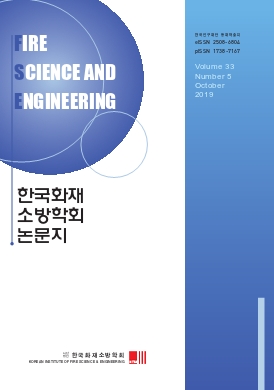공연장 화재 축소모형을 이용한 전산시뮬레이션 검토
Examination on Numerical Simulation Using Reduced-scale Model of Theater Fire: Influences of Fire Curtain and Stage Natural Vent
- 한국화재소방학회
- 한국화재소방학회논문지
- Vol.33 No.5
-
2019.1037 - 47 (11 pages)
- 106

본 연구에서는 Fire Dynamics Simulator (FDS)를 이용한 공연장 화재 축소모형 전산시뮬레이션(Numerical simulation)을 통해 공연장 화재 시 방화막 설치 여부 및 무대부 자연배출구 개폐 영향을 검토하였다. 기존의 축소모형 실험 연구를 바탕으로, 실존하는 공연장에 대해 상사법칙을 적용하여 1/14 비율로 축소하여 설정한 축소모형 및 조건을 대상으로 하였다. 축소모형 전산시뮬레이션을 통해 연기 유동을 가시화하고, 무대부 및 객석부 온도, 자연배출구를 통한 유출 질량 유량, 객석부로의 연기 유출 시작 시점을 측정하고 분석하였다. 전반적으로, 본 전산시뮬레이션에서 예측된 방화막 설치 여부 및 무대부 자연배출구 개폐 영향에 대한 일반적인 경향은 기존 축소모형 실험에서와 유사한 것으로 나타났다. 본 전산시뮬레이션 결과와 기존 축소모형 실험 결과 간 정량적인 비교를 위해 무대부 및 객석부 온도, 자연배출구를 통한 유출 질량 유량에 대해 평균 백분율 오차를 계산하였고, 본 전산시뮬레이션 결과와 기존 축소모형 실험 결과가 비교적 일치함을 확인하였다.
In the present study, the influences of the fire curtain and natural vent in a theater fire were investigated through the numerical simulation of a reduced-scale model of a theater fire using the Fire Dynamics Simulator (FDS). Based on a previous experimental study using the reduced-scale model, the 1/14 reduced-scale model and its conditions were constructed according to the law of similarity with a real-scale theater. Through a series of numerical simulations, the smoke movements were visualized, and the temperatures in the stage and auditorium, mass flow rate of the outflow through natural vent, and time at which smoke started moving toward the auditorium were measured and analyzed. The general trends on the effects of the fire curtain and natural vent during the theater fire predicted by the present numerical simulation were similar to the previous experimental results. For quantitative comparison of the present numerical simulation and previous experimental results, the mean percentage errors of temperatures in the stage and auditorium, and the mass flow rate of outflow through the natural vent were calculated. The present numerical simulation results showed good agreement with previous experimental results with reasonable accuracy.
1. 서 론
2. 전산시뮬레이션 방법 및 조건
3. 전산시뮬레이션 결과 및 분석
4. 결 론
(0)
(0)